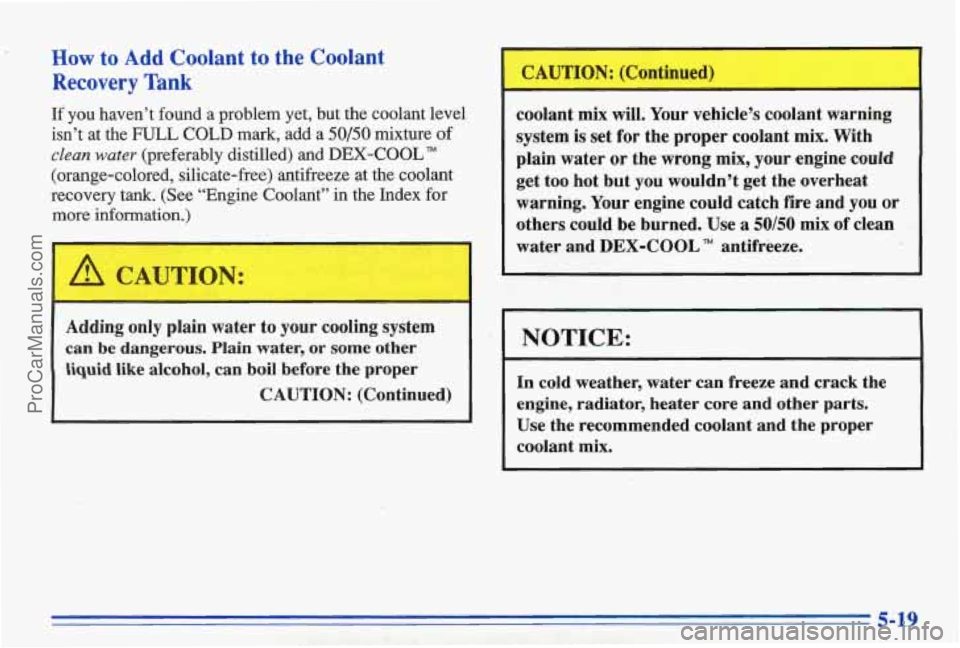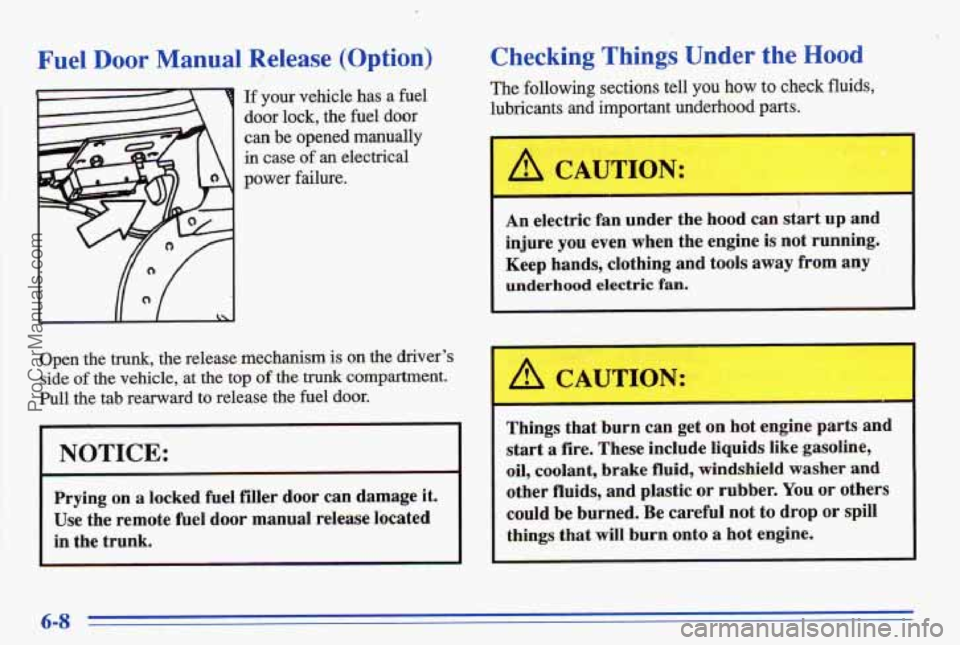Page 222 of 387
Cooling System
When you decide it's safe to lift the hood, here's what
you'll see:
C
An electric fan under the hood can start up even
when the engine is not running and can injure
you. Keep hands, clothing and tools away from
any underhood electric fan.
If the coolant inside the coolant recovery tank is boiling,
don't do anything else until it cools down.
.
A. Coolant recovery tank
B. Radiator pressure cap
C. Electric engine fans
5-17
ProCarManuals.com
Page 223 of 387
,
‘The coolant level should be at or above the FULL
% COLD mark. If it isn’t, you may have a leak in the
. radiator hoses, heater hoses, radiator, water pump or
somewhere else in the cooling system.
A CAWTION:
Heater and radiator hoses, and other engine
parts, can be
very hot. Don’t touch them. If you
do, you can be burned.
Don’t mn the engine
if there is a leak. If you run
’ the engine, it could lose all coolant. That could
cause an engine
fire, and you could be burned.
Get any leak fixed before you drive the vehicle.
I NOTICE:
I
Engine damage from running your engine
without coolant isn’t covered by your warranty.
I
If there seems to be no leak, with the engine on, check to
see if the electric engine fans are running. If the engine
is overheating, both fans should be running. If they
aren’t, your vehicle needs service.
ProCarManuals.com
Page 224 of 387

How to Add Coolant to the Coolant
Recovery Tank
If you haven’t found a problem yet, but the coolant level
isn’t at the
FULL COLD mark, add-a 50/50 mixture of
clean water (preferably distilled) and DEX-COOL TM
(orange-colored, silicate-free) antifreeze at the coolant
recovery tank. (See “Engine Coolarit” in the Index for
more information.)
Adding only plain water to your cooning system
can be dangerous. Plain water, or some other
liquid like alcohol, can boil before the proper
CAUTION: (Continued) -coolant
mix will. Your vehicle’s coolant warning
system
is set for the proper coolant mix. With
plain water or the wrong mix, your engine could
get too hot but you wouldn’t get the overheat
warning. Your engine could catch fire and you or
others could be burned. Use a
50/50 mix of clean
water and
DEX-COOL TM antifreeze.
NOTICE:
In cold weather, water can freeze and crack the
engine, radiator, heater core
and other parts.
Use the recommended coolant and the proper
coolant mix.
ProCarManuals.com
Page 225 of 387
I
I A CAUTION:
If the overheat warning continues, there's one more
thing you can
try. You can add the proper coolant mix
dire'ctly to the radiator, but b'e sure the cooling system is
cool before you do it.
You can be burned if you spill coolant
on hot
engine parts. Coolant contains ethylene glycol
and it will burn
if the engine parts are hot
enough. Don't spill coolant
on a hot engine.
When the coolant
in the coolant recovery tank is at the
FULL COLD mark, start your vehicle. Steam
and scalding liquids from
a hot cooling
system can blow out and burn you badly. They
are under pressure, and if you turn the radiator
pressure cap
-- even a little -- they can come out
at high speed, Never turn the cap when the
cooling system, including the radiator pressure
cap, is
hot. Wait for the cooling system and
radiator pressure cap to cool
if you ever have to
turn the pressure cap.
5-20
ProCarManuals.com
Page 226 of 387
How to Add Coolant to the Radiator
1. You can remove the radiator pressure cap when the
cooling system, including the radiator pressure cap
and upper radiator hose,
is no longer hot. Turn the
pressure cap slowly counterclockwise until it first stops. (Don’t press down while turning the
pressure cap.)
If you hear a
hiss, wait for that to stop. A hiss means
there is still some pressure left.
ProCarManuals.com
Page 228 of 387
4. Then fill the coolant recovery tank to the FULL
COLD mark.
5. Put the cap back on the coolant recovery tank, but
leave the radiator pressure cap
off.
6. Start the engine and let it mn until you can feel the
upper radiator hose getting hot. Watch out for the
engine fans.
filler neck
may be lower. If the level is lower, add '
more of the proper mix through the filler neck until
the level reaches the base of the filler neck.
7. By this time the coolant level inside the radiator
ProCarManuals.com
Page 253 of 387

Fuel Door Manual Release (‘Option)
L
If your vehicle has a fuel
door lock, the fuel door
can be opened manually
in case of an electrical
power
failure.
Y
Open the trunk, the release mechanism is on the driver’s
side
of the vehicle, at the top of the trunk compartment.
Pull the tab rearward
to release the fuel door.
NOTICE:
Prying on a locked fuel filler door can damage it.
Use the remote fuel door manual release located
in the trunk.
Checking T,hings Under the Hood
The following sections tell you how to check fluids,
lubricants and important underhood
parts.
A CAUTION:
i
An electric fan under the hood can start up and
injure you even when the engine
is not running.
Keep hands, clothing and tools away from any
underhood electric fan.
A CAUTION:
Things that burn can get on hot engine parts and
start
a fire. These include liquids like gasoline,
oil, coolant, brake fluid, windshield washer and
other fluids,
and plastic or rubber. You or others
could be burned. Be careful not to drop
or spill
things that will burn onto a hot engine.
6-8
ProCarManuals.com
Page 255 of 387
3800 Series I1 Engine (L36 - Code K)
When you open the bod, you’ll see:
A. Engine Coolant Recovery Tank
B. Battery
C. Radiator Pressure Cap
D. Engine Oil Dipstick G. Brake Master Cylinder
E. Engine Oil Fill Cap H. Air Cleaner
F. Automatic
Transaxle Fluid Dipstick I. Windshield Washer Fluid Reservoir
6-10
ProCarManuals.com